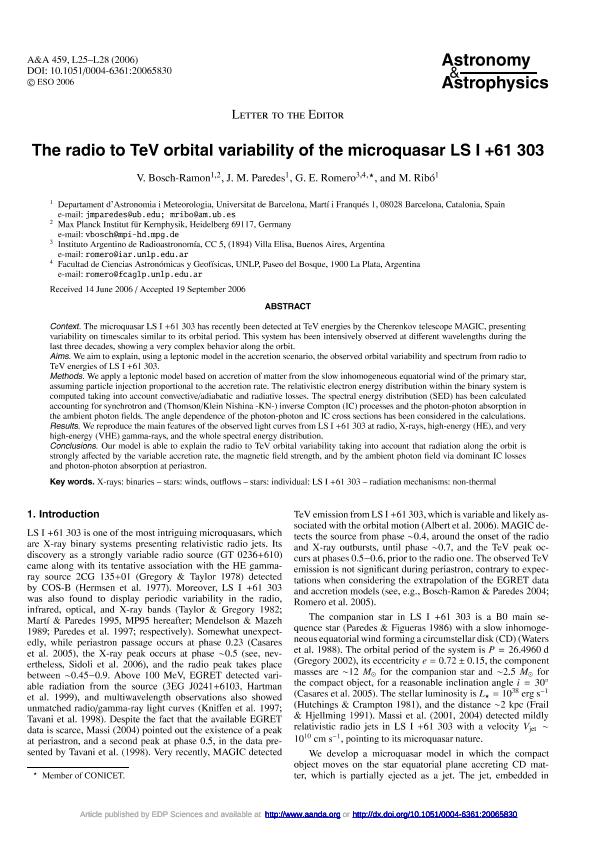Artículo
The radio to TeV orbital variability of the microquasar LSI+61303
Fecha de publicación:
11/2006
Editorial:
EDP Sciences
Revista:
Astronomy and Astrophysics
ISSN:
0004-6361
Idioma:
Inglés
Tipo de recurso:
Artículo publicado
Clasificación temática:
Resumen
Context: .The microquasar LS I +61 303 has recently been detected at TeV energies by the Cherenkov telescope MAGIC, presenting variability on timescales similar to its orbital period. This system has been intensively observed at different wavelengths during the last three decades, showing a very complex behavior along the orbit.Aims: .We aim to explain, using a leptonic model in the accretion scenario, the observed orbital variability and spectrum from radio to TeV energies of LS I +61 303.Methods: .We apply a leptonic model based on accretion of matter from the slow inhomogeneous equatorial wind of the primary star, assuming particle injection proportional to the accretion rate. The relativistic electron energy distribution within the binary system is computed taking into account convective/adiabatic and radiative losses. The spectral energy distribution (SED) has been calculated accounting for synchrotron and (Thomson/Klein Nishina -KN-) inverse Compton (IC) processes and the photon-photon absorption in the ambient photon fields. The angle dependence of the photon-photon and IC cross sections has been considered in the calculations.Results: .We reproduce the main features of the observed light curves from LS I +61 303 at radio, X-rays, high-energy (HE), and very high-energy (VHE) gamma-rays, and the whole spectral energy distribution.Conclusions: .Our model is able to explain the radio to TeV orbital variability taking into account that radiation along the orbit is strongly affected by the variable accretion rate, the magnetic field strength, and by the ambient photon field via dominant IC losses and photon-photon absorption at periastron.
Archivos asociados
Licencia
Identificadores
Colecciones
Articulos(IAR)
Articulos de INST.ARG.DE RADIOASTRONOMIA (I)
Articulos de INST.ARG.DE RADIOASTRONOMIA (I)
Citación
Bosch Ramon, Valentí; Paredes, Josep Maria; Romero, Gustavo Esteban; Ribó, Marc; The radio to TeV orbital variability of the microquasar LSI+61303; EDP Sciences; Astronomy and Astrophysics; 459; 2; 11-2006; 25-28
Compartir
Altmétricas




